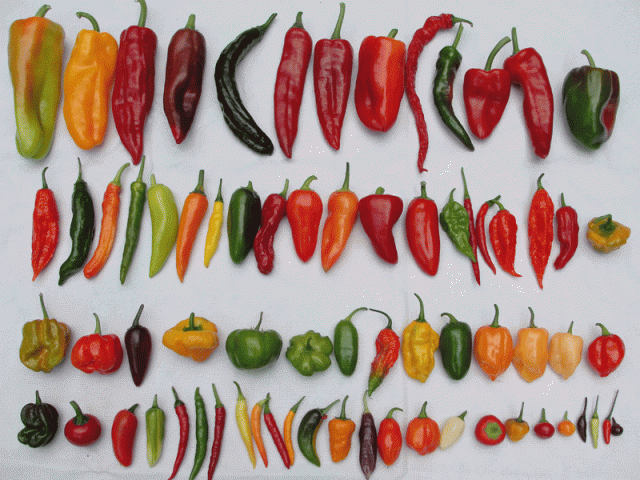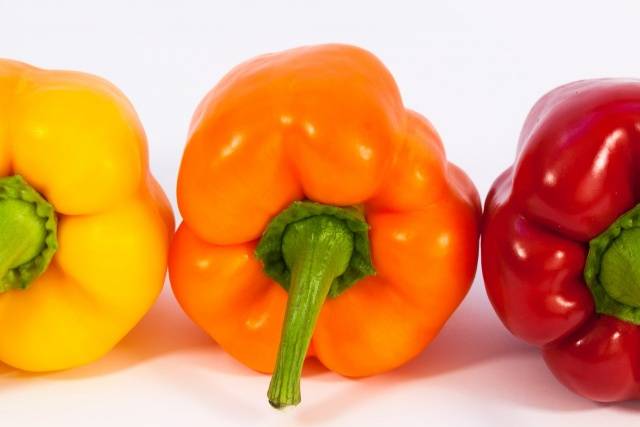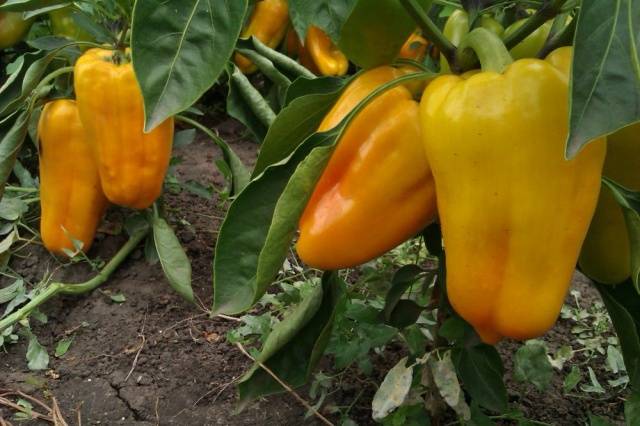Content
Bell pepper belongs to the heat-loving crops of the nightshade family. Its fruit is considered a false berry, hollow and containing many seeds. Bulgarian or, as it is also called, Bell pepper came to Russia from Latin America. There, this crop is considered a perennial crop, but in the local climate, where summers are short and cool, peppers grow only for one season.
For summer residents and gardeners on the eve of the new season, the question of choice is relevant. pepper varieties for landing. What varieties of peppers to choose, how to grow this vegetable correctly - all this can be learned from this article.
How do varieties differ?
All varieties of bell peppers are self-pollinating. In order for the ovaries to appear, insects or human help are not needed - the flowers are pollinated without outside help.
Bell pepper differs according to several criteria, such as:
- The shape and size of the fruits - there are round vegetables, oblong, very large and small.
- Shade of the vegetable - fruits are found in green, red, white, purple, yellow.
- Ripening dates: early, middle and late ripening fruits.
- Varieties and hybrids.
- The growing season is the time it takes for seeds to grow into mature vegetables.
When choosing varieties of peppers for a plot, it is necessary to take into account all these qualities - this is the only way the harvest will please the owner.
How peppers are grown
Regardless of the variety, the method of growing these vegetables is practically the same. Bell peppers, above all, love heat.. In the southern regions, these vegetables can be grown directly in the beds, but in the north of the country it is better to choose cold-resistant hybrid varieties or plant the plants in a greenhouse.
In the Russian climate, sweet peppers need to be planted in seedlings. The growing season of this plant is quite long - about 100 days. To somehow shorten this time, Seedlings begin to be prepared in early February.
The selected pepper variety must be prepared for planting, for this:
- In the fall, a suitable site is chosen - a sunny place protected from the wind. The soil should be loose and fertile, with a neutral acidity level.
- The soil is fertilized with mullein or bird droppings; you can buy ready-made ammonia fertilizer. Fertilizers are spread in the fall before digging up the site. But you can do this in the spring, a couple of weeks before planting the seedlings.
- Pepper seeds planted according to a 6x6 cm pattern in a common box. Keep under film until the first shoots appear. The air temperature for normal development of seedlings should be within 24-27 degrees.
- When the first leaves appear, the seedlings are planted in disposable cups, in each of which one plant is planted.
- You can plant seedlings with 7-8 true leaves in the ground. The air temperature should be at 20 degrees.
- A distance of 30-40 cm is left between the rows, and the same gaps are left between seedlings in the same row.
Peppers need regular and abundant watering., if the plants do not have enough moisture, they will remain short, and the fruits will be dwarf and underdeveloped.
Bell pepper bears fruit for a long time - more and more inflorescences appear on the bushes. At the beginning of August, the tops of the bushes need to be pinched and all the flowers picked off. They will not have time to ripen into a normal vegetable, but late ovaries can harm growing peppers.
Bell peppers are picked slightly greenish; they gain maturity during storage. With this approach, productivity can be significantly increased.
The best varieties of bell pepper
If you read reviews from gardeners and summer residents from different regions of the country, you can understand that each of them has their own favorite variety. Moreover, new varieties appear every year, and 2022 will not be an exception.
The choice of variety should be based not only on the preferences of the owner, but also on the characteristics of the site. Pepper needs the right soil composition, regular watering and careful care - this vegetable does not grow on its own, it needs to be well cared for.
The next step in choosing a pepper variety is the method of growing it: in open ground or in a greenhouse. For open ground, especially in the northern regions, only early varieties of bell pepper are suitable. Medium and late-ripening peppers simply do not have time to ripen in a short summer period.
For the south and center of the country, varieties with any ripening speed are suitable, but for the North it is better to choose early-ripening peppers.
"Big Mama"
Bell pepper "Big Mama» is valued for its taste - its pulp is very aromatic and juicy. The fruits can be used for preparing salads, any other dishes and canning.
The bushes grow tall - up to 100 cm, and spreading. The branches have many ovaries with large fruits, weighing up to 200 grams. The wall thickness of the fruit is about 13 cm, it is a fleshy variety.
Ripe fruits are colored deep orange. You can enjoy the first vegetables on the 120th day after planting the seeds for seedlings. The vegetable can be grown both in open ground and in a greenhouse.
"Bogatyr"
One of the mid-season varieties is “Bogatyr”. The first fruits appear on the bushes on the 120th day after sowing the seeds. The bushes are quite spreading and tall - up to 0.6 meters in height.
Young fruits are green in color, have a slightly bumpy surface and a prism-like shape. By the time it reaches technical maturity, the peel changes color to bright red. The thickness of the fetal walls is 5.5 mm.
Bulgarian pepper "Bogatyr" has excellent taste, it is used for preparing cold and hot dishes, as well as for canning.
This variety can be grown both in a greenhouse and in a garden bed. From one square meter of soil you can get up to 7 kg of large fruits, weighing about 180 grams. The culture is resistant to most diseases typical of peppers.
"Martin"
Mid-early variety "Martin"Bears fruit on the 110th day after planting in the ground. Pepper is suitable for growing in any way: in a greenhouse, greenhouse or garden bed.
In order to harvest a bountiful harvest, it is necessary to break off the upper shoots before the first branch. This shape ensures the appearance of many ovaries on the side branches. The height of the bushes reaches 0.6 meters.
The fruits are smooth, cone-shaped and light green in color. Vegetables can be picked when their skin turns scarlet and the wall thickness reaches 5 mm. The weight of a mature fruit of this variety will be 90 grams.
With proper care and formation of the bush, the yield of the variety is quite high, the fruits have good taste.
"Atlant"
One of the early varieties that ripen on the 110th day is “Atlant" The bushes of this plant are small but spreading, the leaves are also small. But the fruits grow large - weighing up to 170 grams.
The ripeness of vegetables can be determined by the bright green color of the peel. Picked vegetables are stored for a long time and tolerate transportation well; as they ripen, the peppers turn red.
Inside, the fruit is divided into three chambers with seeds, the pulp is quite juicy - the wall thickness is 6 mm. With proper care, you can get up to 5 kg of vegetables per square meter of land planted with this variety.
"Belozerka"
Bulgarian Belozerka pepper It is considered one of the most common in Russian garden plots. This is due to the high yield - with proper care, up to 8 kg of excellent vegetables can be harvested from a meter of soil.
The fruits ripen on the 112th day after sowing the seeds, which makes it possible to classify “Belozerka” as an early variety. Their shape is cone-shaped, with a pointed tip. The peel is slightly ribbed and can have several shades - from beige to red.
The thickness of the walls of the fruit reaches 7.5 mm, and the weight of one vegetable is 130 grams. The fruits ripen smoothly and are distinguished by excellent taste.Peppers of this variety can be eaten raw, canned, and pickled.
Compact bushes are resistant to most diseases of nightshade crops. Pepper can be grown in open ground, the yield of the variety reaches 8 km². Vegetables are well stored and transported.
"Big Daddy"
The super-early sweet hybrid “Big Papa” produces its first fruits already on the 92nd day after planting the seeds in the soil. The crop can be grown both in open ground and under temporary shelter. The bushes grow small and have many leaves and flowers.
Peppers can be picked from the bushes when their color becomes purple. During storage, the fruits ripen and acquire a dark brown color. The shape of the fruit is cone-shaped, the weight reaches 150 grams, and the wall thickness is 8 mm.
That's why Big Papa peppers are very juicy and appetizing. They produce a yield of up to 9 kg and tolerate transportation well.
"California Miracle"
Another early ripening variety - “California miracle» produces the first fruits on the 120th day after planting the seeds. The bushes grow quite tall, reaching 100 cm. They can be grown both under film and in open ground.
The fruits are cube-shaped, ribbed walls with 8 millimeters of pulp. The fruits can be picked when their shade turns bright green; after ripening, the color changes to red.
The yield of the variety is 3 kg per meter of land. Vegetables are suitable for fresh consumption and canning.
"Orange Miracle"
Very productive and early ripening variety - “Orange miracle" Peppers ripen on the 110th day after planting. It is better to grow them in the southern regions of Russia, or use temporary shelters and greenhouses.
The fruits have a bright orange peel and are cubic in shape. The weight of one pepper can reach 250 grams.The vegetables are not only large, but also very juicy, because their walls are 10 mm thick.
The bushes grow tall, reaching 1 meter. The plant is resistant to tobacco mosaic virus and several other diseases. Peppers can be eaten raw or used for storage and canning.
With proper care, you can remove up to 14 kg of vegetables from one meter of bed.
"Gogoshar"
One of the most popular varieties, it is mid-season - the first fruits can be harvested on the 120th day after planting. The bushes grow small and low - up to 50 cm. The peppers themselves are also small - up to 10 cm in diameter, have a round shape and green color. Once ripe, the skin of the peppers turns bright red.
The weight of one fruit is 50-80 grams, the pulp is quite juicy, and the wall thickness is 5 mm.
Grow Bulgarian pepper variety "Gogoshary" It is possible both in the shelter and in the garden. The plant is resistant to diseases and has good productivity - up to 5 kg of vegetables come out of every meter of land.
"Gladiator"
The variety is best grown in areas protected from the wind - it has spreading bushes reaching a height of 80 cm. The plant is resistant to diseases characteristic of peppers and produces high yields - up to 5 kg.
It is better to grow the pepper variety in open ground, but it is also possible under temporary shelters.
Peppers grow quite large, their weight is about 250 grams. Peel color – yellow, shape – prism-shaped, surface – glossy.
The thickness of the fruit walls is 6 mm - the peppers are very juicy and have a sweetish taste and a special aroma. The fruits contain a lot of vitamin C and other beneficial microelements, so they are best eaten raw. But you can also preserve it, salt it, and stew it.
The first vegetables will appear in the garden no earlier than the 110th day after sowing the seeds. Ripe peppers tolerate transportation well and can be stored for a long time.
"Gift of Moldova"
One of the most favorite varieties of bell pepper, most often used by domestic summer residents and gardeners.
This pepper is loved for its excellent taste and high yield. The culture is suitable for growing in a greenhouse and in open ground. Able to adapt to the climatic conditions of the region, but bears fruit best in the south.
The first fruits appear only on the 130th day after planting, but they ripen smoothly. This allows the variety to be used for industrial cultivation, when vegetables are harvested not by hand, but by special equipment.
The pepper bushes are low - only 45 cm, quite spreading. The peppers themselves are small - weighing up to 90 grams, but have thick flesh and a pleasant taste.
Grow "Gift from Moldova"It is possible not only in the fields, but also in greenhouses and garden beds.
What types and varieties to plant in spring 2022
Using the examples given varieties of peppers with photos and the description shows how these cultures differ and what advantages they have. Knowing the strengths and weaknesses, it is easy to choose the most suitable pepper varieties for a particular case.
It is important to remember that a vegetable should not only be beautiful and productive, but also tasty.. It contains many vitamins and microelements necessary for the body; pepper should be eaten both raw and cooked.

























